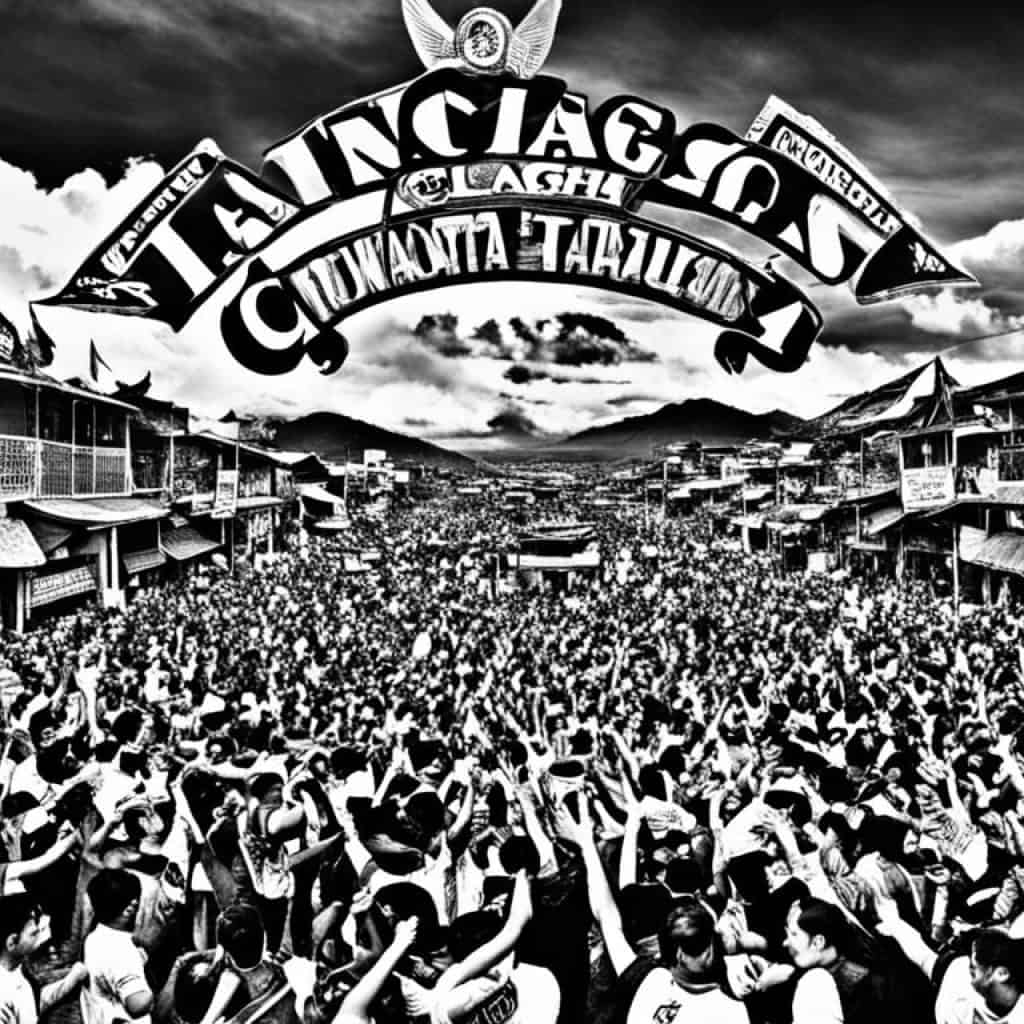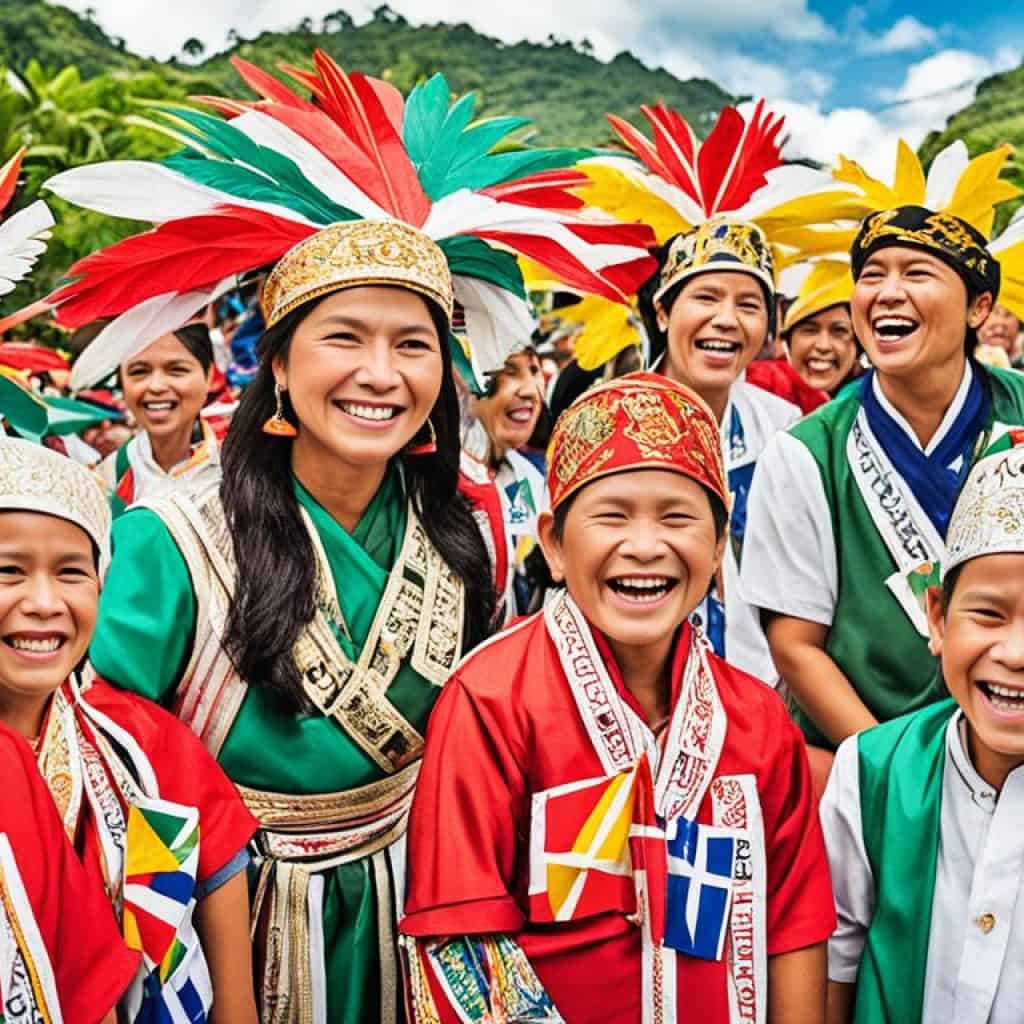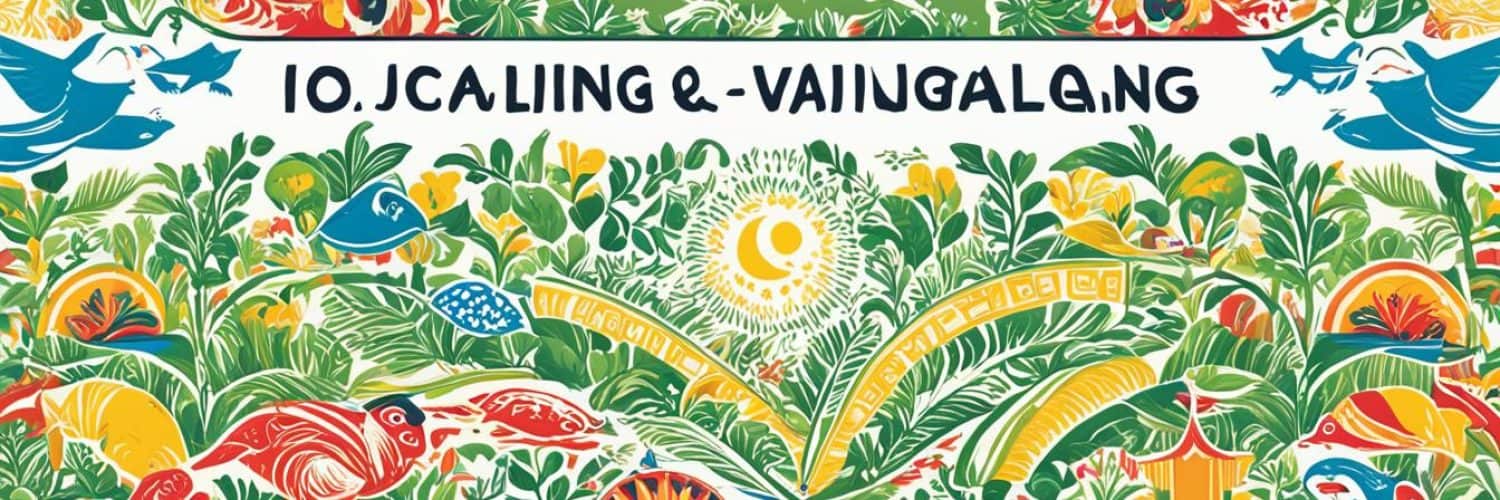Have you ever asked yourself about how different Ilocano and Tagalog are? These two major Philippine languages are really interesting. They show us the rich differences in culture and language within the country. What makes Ilocano and Tagalog stand out from each other? We’re going to explore what sets these languages apart. Join us as we dive into this linguistic battle and celebrate the diversity it represents.
- Ilocano and Tagalog are major languages in the Philippines, with distinct characteristics and dialects.
- Ilocano is widely spoken in northern Luzon and serves as a main language for trade and communication.
- Tagalog, native to Manila and surrounding provinces, is the basis for the national language, Filipino.
- Understanding the differences between Ilocano and Tagalog contributes to a deeper appreciation of Philippine linguistic diversity.
- Stay tuned to uncover the unique features and cultural significance of these fascinating languages in the upcoming sections.
Overview of Philippine Languages
The Philippines is full of different languages, with over 150 types. These languages come from the Austronesian family, mainly the Western Malayo-Polynesian group. They grew from the original language of the early locals. Many Philippine languages have lots of dialects and some have over a million speakers.
Two major languages, Ilocano and Tagalog, play big roles in the nation’s culture and communication. Millions of people speak these languages. They are very important to the country’s heritage.
To really understand the variety of languages in the Philippines, we need to look closely at Ilocano and Tagalog. We’ll explore their history, special features, and what they mean to the culture.
The image above shows the beauty and complexity of Philippines’ languages. It signifies the country’s rich culture and how people connect through language.
| Language | Language Family | Dialect Chains |
|---|---|---|
| Tagalog | Austronesian | Extensive |
| Ilocano | Austronesian | Extensive |
| … | … | … |
The Role of Dialect Chains
Dialect chains in the Philippines show how languages connect regions. They help communities talk to each other and share cultures. By studying these chains, we see the variety and connections among the Philippine languages.
“Dialect chains in the Philippines form a fascinating web of language variation, connecting communities and regions in a linguistic tapestry.” – Linguistics Expert
Learning about languages like Ilocano and Tagalog shows us the deep culture and identity of the Filipino people. It’s more than words, it tells us about their rich heritage.
Importance of Tagalog in the Philippines
Tagalog is also called Filipino and is very important in the Philippines. It is spoken by about 15 million people. Originating in Manila and nearby areas, it is the foundation of Filipino, the national language.
Tagalog is more than a way to talk. It’s key in media like movies, TV, and comics. It shapes the entertainment and culture in the Philippines.
In Philippine schools, Tagalog is a must-learn subject. This ensures students are fluent in their national language. So, Tagalog is becoming a common second language in the country.
“Tagalog is not just a language; it is a gateway to understanding the heart and soul of the Filipino people.”
Influence in Media and Popular Culture
Tagalog is everywhere in Philippine media. It reaches more people through films, TV, music, and stories. It captures the wide range of Filipino life from romance to comedy.
“Komiks” or Tagalog comics are big in the Philippines. They tell stories with pictures, showing Filipino values. They entertain and teach, reflecting what Filipinos hold dear.
“Tagalog helps create a sense of unity and shared experiences, connecting Filipinos from various regions and backgrounds.”
Foundation of Filipino Identity
Tagalog being named the national language marks its importance in Filipino identity. It unites various cultures and languages in the Philippines. Filipino, blending elements from other Philippine languages, showcases Filipino heritage.
In schools, learning Filipino builds national pride and cultural love. Students discover their history, literature, and traditions through Tagalog.
Tagalog in the Philippines
| Aspect | Importance |
|---|---|
| Communication | Widely spoken language with approximately 15 million native speakers |
| Media | Language of movies, television shows, music, and literature; shapes popular culture |
| Education | Required subject in all schools; key to developing language proficiency and cultural understanding |
| National Identity | Foundation of the Filipino identity as the basis for the national language, Filipino |
Tagalog’s role in the Philippines is huge. As the national language and a cultural base, it’s vital in communication, media, education, and building Filipino identity. Embracing Tagalog unites the country and connects us to our rich cultural roots.
Importance of Ilocano in the Philippines
The Ilocano language is very important in the Philippines, not just locally but also more broadly. It’s the main language for trade in northern Luzon. This makes it essential for business and communication within the area.
Ilocano is also found in parts of southern Mindanao. This shows how far the language has reached. The expansion of Ilocano is thanks to Ilocanos moving and living in new areas.
The Ilocano people moving abroad have also made the language well-known outside the Philippines. They have taken their language to the United States and other places. This helps keep the language alive and cherished among their communities.
Ilocano stands as a marker of identity and heritage. It connects Ilocano speakers to their roots and culture. It’s a way for them to keep close to their homeland and traditions.
Linguistic Assimilation
Linguistic assimilation is key in the Philippines’ language policy. The country has seen the rise of certain languages, influencing language use and education. The Spanish era brought Spanish language elements into Philippine languages. Then, English took over during American colonization, changing the country’s language landscape.
Loanwords from Spanish and English are now common in Philippine languages. This shows the impact of these languages over time. These borrowings have blended well, making communication easier across different linguistic groups.
“Linguistic assimilation has changed Philippine languages, with dominant languages leaving a strong mark. The adoption of Spanish and English words and grammar shows how languages evolve and adapt over time.”
The preference for English and Spanish has shaped language education in the Philippines. Schools focus on these languages, seen as keys to success. This has often left local languages behind, reducing fluency among speakers.
However, the Philippines is now valuing its linguistic diversity more. There are efforts to revive and standardize local languages. These initiatives aim for a language policy that honors the country’s linguistic roots. They seek to balance assimilation with the preservation of indigenous languages, encouraging a diverse and multilingual society.
Vernacularization
Vernacularization emphasizes the value of native languages in policies and planning. In the Philippines, efforts focus on reviving and standardizing these languages. This includes using them in education with the Mother Tongue-Based Multilingual Education policy. Vernacularization seeks to preserve linguistic diversity.
It prioritizes the revival and standardization of indigenous languages, recognizing their cultural and historical importance. This approach values the indigenous knowledge, traditions, and perspectives within the vernacular.
“Embracing vernacularization not only preserves linguistic diversity but also fosters a sense of identity and belonging,” says Dr. Maria Santos. She highlights the importance for communities whose languages were marginalized.
With the Mother Tongue-Based Multilingual Education policy, native languages are instruction mediums in early grades. This builds a strong foundation in the mother tongue. It also makes learning more effective and helps preserve these languages.
Moreover, standardizing indigenous languages boosts communication and understanding within the Philippines. It establishes common grammar, vocabulary, and spelling. This enhances language use and encourages inter-cultural dialogue.
Revival and Standardization Efforts
The process of reviving and standardizing indigenous languages involves linguists, educators, and community leaders. They create language resources like manuals, dictionaries, and teaching materials. There are also language revitalization initiatives.
Language centers and institutes play a key role. They work with native speakers and scholars. Their goal is to develop orthographies and grammar rules that respect the language’s authenticity while meeting modern standards.

Preserving Linguistic Diversity
Vernacularization is key to preserving linguistic diversity in the Philippines, with over 150 languages spoken. By revitalizing and standardizing these languages, it ensures they remain part of the Filipino linguistic heritage.
This effort promotes inclusivity and empowers communities to express in their native tongue. It shows the significance of language for cultural preservation, social cohesion, and individual identity.
The Importance Moving Forward
As vernacularization progresses in the Philippines, sustaining momentum is crucial. This means integrating it into broader language policies and education. Support and investment from the government and communities are essential.
Vernacularization can spark social and cultural change, empowering indigenous communities. It encourages appreciation for the Philippines’ linguistic diversity. By valuing indigenous languages, the nation fosters a more inclusive society that celebrates all voices.
Linguistic Pluralism
Linguistic pluralism celebrates many languages in a society. In the Philippines, it shows the country’s rich language variety. It also highlights the importance of language rights.
Over 150 languages are spoken in the Philippines. Linguistic pluralism values this language variety. It understands that each language is important to cultural identity.
Linguistic pluralism focuses on saving and promoting language diversity. It fights for communities to use and grow their native languages. This ensures everyone is included in a society with many languages.
“Language rights are fundamental human rights. Preserving linguistic diversity is not only about protecting languages, but also about respecting the rights of individuals and communities to express themselves in their mother tongue.”
Linguistic pluralism is about more than just accepting different languages. It celebrates what each language adds to the Philippines’ culture. It helps different language speakers understand and appreciate each other.
By supporting linguistic pluralism, the Philippines shows that language does more than help us communicate. It shapes our cultural identity. It also keeps traditional knowledge alive and gives us a sense of belonging.
Internationalization of English
English has spread widely in the Philippines, shaped by colonial history and globalization. Once the tongue of colonizers, it’s now key in communication, business, and education. This shift has deeply influenced the country’s linguistic scene.
English’s colonial roots have left a strong mark on the Philippines. During American rule, English was the teaching language in schools. This has made English a powerful language in commerce and business today.
English is vital for the Philippines’ trade and economic growth. Global companies set up call centers and English schools there because Filipinos are good at English. These sectors have boosted jobs and the economy.
Also, English is used for teaching in higher education. This attracts students globally to study in the Philippines. Using English at universities helps share knowledge, letting Filipino students shine internationally.
The internationalization of English has enabled the Philippines to connect with the global community, fostering cultural exchange and international collaborations.
But, the rise of English also brings challenges in keeping language diversity. It can push local languages and dialects aside, risking linguistic and cultural loss.
The Philippines values its languages and works to keep them alive. It aims for a balance between embracing English and protecting local tongues. One approach is the Mother Tongue-Based Multilingual Education policy. It promotes native languages in schools while also teaching Filipino and English.
Table: English Language Proficiency in the Philippines
| Proficiency Level | Estimated Percentage of Population |
|---|---|
| Native Speakers | 10% |
| High Proficiency | 20% |
| Moderate Proficiency | 40% |
| Basic Proficiency | 30% |
- The internationalization of English has transformed the linguistic landscape of the Philippines.
- English has become a language of commerce, education, and communication.
- It has contributed to the success of industries such as call centers and English language schools.
- English proficiency is essential for economic growth and participation in global markets.
- Efforts are being made to balance the internationalization of English with the preservation of local languages.
The Philippines keeps working through the issues and debates around English’s global role. It sees the value of English and local languages in shaping its culture and future.
English Language and Filipino Population
English is key for the Filipino population’s growth. Being one of the biggest English-speaking countries, the Philippines sees English as crucial for success and global engagement. Yet, keeping up English skills has been tough.
Using English in schools has led to lower proficiency. This focus might hinder promoting many languages and local dialects. Many Filipinos, including students, feel anxious and struggle to communicate well in English.
“The ability to effectively communicate in English is crucial for individual success and economic growth in today’s globalized world.” – John David, English Educator
A drop in English skills can slow economic progress, as English is vital in numerous industries and global trade. We need to find a middle ground between English skills and valuing our local culture and languages.
The Impact on Economic Growth
Good English skills help the economy grow. People who speak English well are more likely to get jobs in fields like business outsourcing and tourism. These sectors are big parts of the Philippine economy.
Also, being good at English helps Filipinos in global trade. English is usually the language of international business. So, being able to speak English well can open many doors.
Language Challenges and Anxiety in Communication
Stressing over English education can cause issues and anxiety. Many people worry about making mistakes or not living up to expectations. This makes them anxious about using English.
Also, focusing a lot on English might make us forget the importance of local languages and dialects. We need to appreciate and support linguistic diversity while improving English skills.
Striving for Balance and Multilingualism
We must aim for multilingualism and a balanced approach to teaching languages. Valuing English while also keeping and growing our local languages can make us proud and inclusive.
There should be enough support for learning English, dealing with challenges and communication worries. At the same time, promoting local languages in media, literature, and schools can help maintain linguistic diversity and strengthen communities.
Image: Illustration depicting the anxiety experienced by individuals when communicating in English.
Language Use in Education in the Philippines
In the Philippines, the primary language in schools is the students’ native language. The Mother Tongue-Based Multilingual Education policy by the Department of Education uses native languages as the instruction medium from kindergarten to grade three.
This policy, also known as MTB-MLE, aims to make learning better. It builds a strong base in the students’ mother tongue. It also stresses the role of language skills and literacy in early education years.
During this time, students also learn Filipino and English as subjects. This lets them get good at these languages while their native language is used for teaching. This method ensures they move smoothly to using Filipino and English in higher grades.
“The MTB-MLE policy supports native language preservation and makes teaching more effective by using the students’ first language,” notes Dr. Maria Santos, a language education expert.
After the third grade, there’s a program that slowly brings in Filipino and English as main teaching languages. This prepares students to be good at the national language, Filipino, and English. Both are key for success in the Philippines.
The Philippines education system embraces the mother tongue and later adds Filipino and English. This aims to support multilingualism and create a better learning space.
Benefits of Mother Tongue-Based Multilingual Education
There are many pluses to using this teaching approach:
- Improved learning and understanding
- Keeping cultural heritage and language variety alive
- Better language and reading skills
- More excitement and engagement in learning
- Easier move to Filipino and English learning
This policy values the linguistic and cultural rights of students. It underlines the importance of a strong mother tongue base. This helps speed up their language and thinking skills growth.

The Mother Tongue-Based Multilingual Education is key in developing language skills and a love for learning among Filipino students. It supports their mother tongue and slowly introduces Filipino and English. This empowers students to be multilingual. They become well-prepared individuals for the global scene.
Code-Switching in the Philippines
Code-switching is a fascinating way people in the Philippines mix languages. It happens in places like schools and on the internet. Teachers and students use it in classrooms to make learning easier.
Bilingual Filipino teachers use code-switching to explain tough concepts. This makes lessons easier to understand. It helps students learn better by making ideas clearer.
Students also mix languages to ask questions or share their thoughts. This makes talking easier and helps them say what they really feel. They draw from a big pool of words.
Code-switching is also big in online talks. Filipinos switch languages easily when they’re online. This lets them express themselves well and connect with others. Their online chats show how versatile and bilingual Filipinos are.
The Role of Bilingualism and Language Versatility
Bilingualism is important in Filipino culture. People often switch languages, showing their skill and flexibility. This skill helps them in different social settings.
Code-switching shows how Filipinos are naturally bilingual and versatile. It improves communication and helps them feel like they belong.
Code-switching also shows why teaching both languages is important. It makes a case for language policies that respect the Philippines’ diverse languages.
Advantages of Code-Switching
Code-switching has many benefits. It helps people talk better and understand each other’s cultures. Here are some main advantages:
- Enhanced comprehension: Mixing languages helps get past language barriers and makes talking clearer.
- Cultural expression: Code-switching lets people add cultural touches to their chats, showing pride in their heritage.
- Linguistic resourcefulness: Being able to switch languages gives people more words and phrases to choose from.
- Building connections: Code-switching helps bilingual people feel closer to each other and appreciate different cultures more.
Code-switching in the Philippines shows the country’s language skills and diversity. It’s a key part of the nation’s culture and celebrates its many languages.
Language Diversity in the Philippines
The Philippines is known for its vast language variety, with over 150 languages. Major languages like Bikolano, Cebuano, Hiligaynon, Ilocano, Kapampangan, Pangasinan, Tagalog, and Waray are spoken. Each language has unique qualities and plays a role in the country’s linguistic richness.
There are also endangered languages spoken by indigenous groups. These languages face threats from urbanization, globalization, and dominant languages. Efforts are now being made to save and document these languages.
Recently, there’s more focus on creating translation systems and research to help endangered languages. These efforts aim to keep these languages alive for future generations. They help preserve the cultural heritage and identity linked to these languages.
The image above shows why saving endangered languages in the Philippines is crucial.
Major Languages of the Philippines
| Language | Native Speakers |
|---|---|
| Bikolano | 2.5 million |
| Cebuano | 20 million |
| Hiligaynon | 9 million |
| Ilocano | 9 million |
| Kapampangan | 2 million |
| Pangasinan | 1.5 million |
| Tagalog | 25 million |
| Waray | 3 million |
The table above lists the major Philippine languages and their speakers. It shows the broad linguistic diversity and the importance of these languages.
Historical Development of LPP in the Philippines
The Philippines has a rich history of language policy and planning (LPP). It’s shaped by colonial rule and the country’s move to independence. Both Spain and the United States influenced the language ideologies here.
This background shows how language, culture, and politics mix in a postcolonial setting.
Under Spanish rule, Spanish was key in teaching and religious conversion. Its impact on language views and schooling practices was deep. Spanish remained influential in some social circles, even after Spain left.
“The historical development of LPP in the Philippines reflects the intricate relationship between language, culture, and politics in a postcolonial context.”
Then, the United States brought English, changing the education and government scenes. English took over Spanish’s top spot. This change affected language policies and the country’s linguistic scene.
After gaining independence, the Philippines still felt colonial language policies’ effects. Efforts to boost national unity led to making Tagalog (now Filipino) the national language. Still, this decision sparked debates about other local languages and excluding non-Tagalog speakers.
| Language Policy and Planning in the Philippines | Key Points |
|---|---|
| Colonial History | – Influence of Spanish and American colonization – Spanish as a dominant language during the Spanish colonial period – Introduction of English as a medium of instruction during American colonization |
| Language Ideologies | – Shaped by colonial powers – Spanish and English as dominant languages – Tension between promoting a national language and preserving linguistic diversity |
The Complexity of Language Policies in the Postcolonial Era
In the postcolonial era, the challenge has been to balance a national language with linguistic diversity. The Philippines values multilingualism and the rights of linguistic groups. Efforts are in place to encourage regional languages while having a shared language for the nation.
The LPP history in the Philippines reminds us of the complex colonial linguistic legacy. It illustrates the role of language views in shaping current policies. It also points out the difficulty in promoting inclusivity and unity while valuing linguistic diversity.
Cobarrubias’ Taxonomy of Language Ideologies
Many ideas have emerged in language planning to help shape language policies and their social effects. Cobarrubias created a way to classify these ideas. His method sorts out different approaches used to influence language policy in various places.
Linguistic Assimilation
Linguistic assimilation promotes the main language while pushing aside minority languages. This view wants everyone to use the main language, dropping all others. In the Philippines, Spanish and English were pushed during their respective colonial eras under this idea.
Vernacularization
Vernacularization values local languages and aims to boost their use and growth. It’s about keeping language variety alive and encouraging local languages in schools and government. This approach wants to give minorities a voice and pride in their own tongues. The Mother Tongue-Based Multilingual Education policy in the Philippines is a great example of this.
Linguistic Pluralism
Linguistic pluralism loves language diversity in society. It pushes for everyone’s right to speak their native languages and promotes acceptance. Rather than one main language, this idea supports many languages living together peacefully. Over 150 languages in the Philippines show how linguistic pluralism is part of its culture.
Internationalization
Internationalization sees the worldwide value of certain languages and encourages their use globally. It points out languages like English as key for international talk, business, and study. The Philippines’ use of English today shows its colonial past and how it’s opened up to the world.
Understanding Cobarrubias’ taxonomy helps us see how different ideas on language planning have shaped policies in the Philippines and elsewhere. By examining each approach’s pros and cons, decision-makers can aim for policies that keep linguistic diversity, preserve culture, and ensure good communication in a world of many languages.
Conclusion
The comparison of Ilocano and Tagalog shows the Philippines’ wide range of spoken languages. This variety mirrors the country’s rich culture and complex language scene. Through looking at the language policy history in the Philippines, we see the impact of different language views. We also notice the efforts to encourage language diversity and inclusion.
Understanding Ilocano and Tagalog helps us value Philippine culture and language heritage more. Language shapes our identity, communication, and community ties. So, valuing all languages is key for an inclusive society.
In the Philippines, the goal is to keep languages like Ilocano alive while also boosting Tagalog as a national language. This task means thinking about language beliefs, how we teach, and the needs of various language groups. As the country moves forward, making sure all languages are respected and given equal rights is crucial.







Add comment